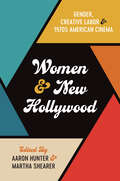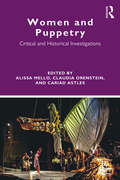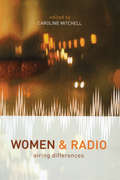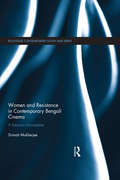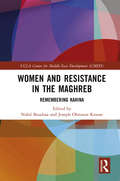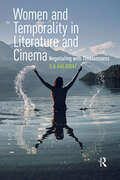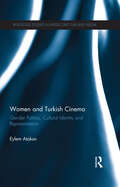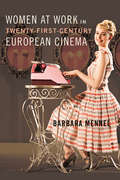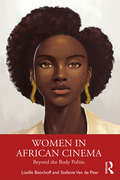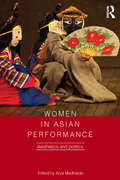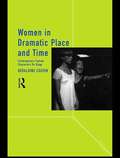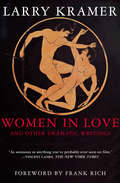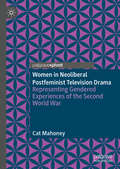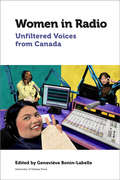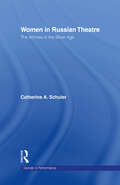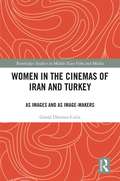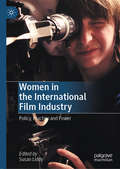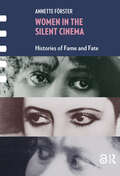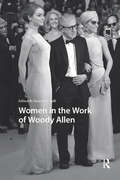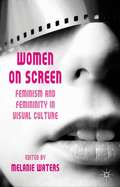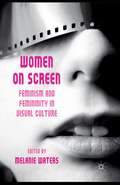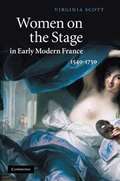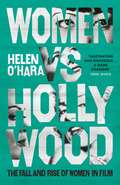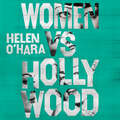- Table View
- List View
Women and New Hollywood: Gender, Creative Labor, and 1970s American Cinema
by James Morrison Amelie Hastie Karen Pearlman Oliver Gruner Nicholas Godfrey Anna Backman Rogers Maria Pramaggiore Maya Montañez Smukler Alicia Kozma Nicholas Forster Abigail Cheever Virginia Bonner Adrian GarveyThe 1970s has often been hailed as a great moment for American film, as a generation of “New Hollywood” directors like Scorsese, Coppola, and Altman offered idiosyncratic visions of what movies could be. Yet the auteurist discourse hailing these directors as the sole authors of their films has obscured the important creative roles women played in the 1970s American film industry. Women and New Hollywood revises our understanding of this important era in American film by examining the contributions that women made not only as directors, but also as screenwriters, editors, actors, producers, and critics. Including essays on film history, film texts, and the decade’s film theory and criticism, this collection showcases the rich and varied cinematic products of women’s creative labor, as well as the considerable barriers they faced. It considers both women working within and beyond the Hollywood film industry, reconceptualizing New Hollywood by bringing it into dialogue with other American cinemas of the 1970s. By valuing the many forms of creative labor involved in film production, this collection offers exciting alternatives to the auteurist model and new ways of appreciating the themes and aesthetics of 1970s American film.
Women and Puppetry: Critical and Historical Investigations
by Alissa Mello Claudia Orenstein Cariad AstlesWomen and Puppetry is the first publication dedicated to the study of women in the field of puppetry arts. It includes critical articles and personal accounts that interrogate specific historical moments, cultural contexts, and notions of "woman" on and off stage. Part I, "Critical Perspective," includes historical and contemporary analyses of women’s roles in society, gender anxiety revealed through the unmarked puppet body, and sexual expression within oppressive social contexts. Part II, "Local Contexts: Challenges and Transformations," investigates work of female practitioners within specific cultural contexts to illuminate how women are intervening in traditionally male spaces. Each chapter in Part II offers brief accounts of specific social histories, barriers, and gender biases that women have faced, and the opportunities afforded female creative leaders to appropriate, revive, and transform performance traditions. And in Part III, "Women Practitioners Speak," contemporary artists reflect on their experiences as female practitioners within the art of puppet theatre. Representing female writers and practitioners from across the globe, Women and Puppetry offers students and scholars a comprehensive interrogation of the challenges and opportunities that women face in this unique art form.
Women and Radio: Airing Differences
by Caroline MitchellCombining classic work on radio with innovative research, journalism and biography, Women and Radio offers a variety of approaches to understanding the position of women as producers, presenters and consumers as well as offering guidelines, advice and helpful information for women wanting to work in radio.Women and Radio examines the relationship between radio audiences, technologies and programming and reveals and explains the inequalities experienced by women working in the industry.
Women and Resistance in Contemporary Bengali Cinema: A Freedom Incomplete (Routledge Contemporary South Asia Series)
by Srimati MukherjeeHistorically, Indian cinema has positioned women at the intersection of tradition and a more evolving culture, portraying contradictory attitudes which affect women’s roles in public and private spheres. Examining the work of three directors from West Bengal, this book addresses the juxtaposition of tradition and culture regarding women in Bengali cinema. It argues the antithesis of women’s roles, particularly in terms of ideas of resistance, revolution, change, and autonomy, by suggesting they convey resistance to hegemonic structures, encouraging a re-envisioning of women’s positions within the familial-social matrix. Along with presenting a perception of culture as dynamic and evolving, the book discusses how some directors show that with this rupturing of the traditionally prohibitive, and a notion of unmaking and making in women, a traditional inclination is exposed to align women with ideas of absence, substitution, and disposability. The author goes on to show how selected auteurs in contemporary Bengali cinema break with certain traditional representations of women, gesturing towards a culture that is more liberating for women. Presenting the first full-length study of women’s changing roles over the last twenty years of Bengali cinema, this book will be a useful contribution for students and scholars of South Asian Culture, Film Studies and Gender Studies.
Women and Resistance in the Maghreb: Remembering Kahina (UCLA Center for Middle East Development (CMED))
by Nabil BoudraaThis book studies women’s resistance in the three countries of the Maghreb, concentrating on two questions: First, what has been the role of women artists since the 1960s in unlocking traditions and emancipating women on their own terms? Second, why have Maghrebi women rarely been given the right to be heard since Algeria, Morocco, and Tunisia gained national independence? Honouring the artistic voices of women that have been largely eclipsed from both popular culture and political discourse in the Maghreb, the work specifically examines resistance by women since 1960s in the Maghreb through cinema, politics, and the arts. In an ancillary way, the volume addresses a wide range of questions that are specific to Maghrebi women related to upbringing, sexuality, marriage, education, representation, exclusion, and historical memory. These issues, in their broadest dimensions, opened the gates to responses in different fields in both the humanities and the social sciences. The research presents scholarship by not only leading scholars in Francophone studies, cultural history, and specialists in women studies, but also some of the most important film critics and practicing feminist advocates. The variety of periods and disciplines in this collection allow for a coherent and general understanding of Maghrebi societies since decolonization. The volume is a key resource to students and scholars interested in women’s studies, the Maghreb, and Middle East studies.
Women and Temporality in Literature and Cinema: Negotiating with Timelessness
by Ila AhlawatWomen and Temporality in Literature and Cinema delves into the subject of literary and cinematic women characters entrapped in temporal spaces and their peculiar communication with visibility, enclosure, space, and time in the context of sexual and temporal discord. It explores subjects such as youth, ageing, remembering, forgetting, and repeating within the larger realm of gendered temporalities that are essentially nuanced and affective experiences. Throughout, this book seeks to locate and spell out the damaging as well as the healing effects of temporality upon women’s consciousness.
Women and Turkish Cinema: Gender Politics, Cultural Identity and Representation (Routledge Studies in Middle East Film and Media)
by Eylem AtakavSince 2000, there has been a considerable effort in Turkish cinema to come to terms with the military’s intervention in politics and subsequent national trauma. It has resulted in an outpouring of cinematic texts. This book focuses on women and Turkish cinema in the context of gender politics, cultural identity and representation. The central proposition of this book is that enforced depolticisation introduced after the coup is responsible for uniting feminism and film in 1980s Turkey. The feminist movement was able to flourish precisely because it was not perceived as political or politically significant. In a parallel move in the films of the 1980s there was an increased tendency to focus on the individual, on women’s issues and lives, in order to avoid the overtly political. Women and Turkish Cinema provides a comprehensive view of cinema’s approach to women in a country which straddles European and Middle Eastern cultural conceptions, identities and religious values and will be an invaluable resource for students and scholars of Film Studies, Gender Studies and Middle East Studies, amongst others.
Women at Work in Twenty-First-Century European Cinema
by Barbara MennelFrom hairdressers and caregivers to reproductive workers and power-suited executives, images of women's labor have powered a fascinating new movement within twenty-first century European cinema. Social realist dramas capture precarious working conditions. Comedies exaggerate the habits of the global managerial class. Stories from countries battered by the global financial crisis emphasize the patriarchal family, debt, and unemployment. Barbara Mennel delves into the ways these films about female labor capture the tension between feminist advances and their appropriation by capitalism in a time of ongoing transformation. Looking at independent and genre films from a cross-section of European nations, Mennel sees a focus on economics and work adapted to the continent's varied kinds of capitalism and influenced by concepts in second-wave feminism. More than ever, narratives of work put female characters front and center--and female directors behind the camera. Yet her analysis shows that each film remains a complex mix of progressive and retrogressive dynamics as it addresses the changing nature of work in Europe.
Women in African Cinema: Beyond the Body Politic
by Lizelle Bisschoff Stefanie Van de PeerWomen in African Cinema: Beyond the Body Politic showcases the very prolific but often marginalised presence of women in African cinema, both on the screen and behind the camera. This study provides the first in-depth and sustained study of women in African cinema. Films by women from different geographical regions are discussed in case studies that are framed by feminist theoretical and historical themes, and seen through an anti-colonial, philosophical, political and socio-cultural cinematic lens. A historical and theoretical introduction provides the context for thematic chapters exploring topics ranging from female identities, female friendships, women in revolutionary cinema, motherhood and daughterhood, women’s bodies, sexuality, and spirituality. Each chapter serves up a theoretical-historical discussion of the chosen theme, followed by two in-depth case studies that provide contextual and transnational readings of the films as well as outlining production, distribution and exhibition contexts. This book contributes to the feminist anti-racist revision of the canon by placing African women filmmakers squarely at the centre of African film culture. Demonstrating the depth and diversity of the feminine or female aesthetic in African cinema, this book will be of great interest to students and scholars of African cinema, media studies and African studies.
Women in Asian Performance: Aesthetics and politics
by Arya MadhavanWomen in Asian Performance offers a vital re-assessment of women's contributions to Asian performance traditions, focusing for the first time on their specific historical, cultural and performative contexts. Arya Madhavan brings together leading scholars from across the globe to make an exciting intervention into current debates around femininity and female representation on stage. This collection looks afresh at the often centuries-old aesthetic theories and acting conventions that have informed ideas of gender in Asian performance. It is divided into three parts: erasure – the history of the presence and absence of female bodies on Asian stages; intervention – the politics of female intervention into patriarchal performance genres; reconstruction – the strategies and methods adopted by women in redefining their performance practice. Establishing a radical, culturally specific approach to addressing female performance-making, Women in Asian Performance is a must-read for scholars and students across Asian Studies and Performance Studies.
Women in Dramatic Place and Time: Contemporary Female Characters on Stage
by Geraldine CousinFirst published in 1996. Routledge is an imprint of Taylor & Francis, an informa company.
Women in Love: And Other Dramatic Writings (Books That Changed the World)
by Larry KramerScreenplays and scripts from the playwright of The Normal Heart.&“A valuable showcase of an important writer&’s early career.&”—The Bay Area Reporter Larry Kramer has been described by Susan Sontag as &“one of America&’s most valuable troublemakers.&” As Frank Rich writes in his Foreword to this collection of writings for the screen and stage, &“his plays are almost journalistic in their observation of the fine-grained documentary details of life . . . that may well prove timeless.&” The title work, the Oscar-nominated screenplay for Women in Love, is a movie &“as sensuous as anything you&’ve probably ever seen on film&” (The New York Times). The screenplay is accompanied by Kramer&’s reflections on the history of the production, sure to be of interest to any student of film. This volume also includes several early plays, Sissies&’ Scrapbook, A Minor Dark Age, and the political farce Just Say No, illuminating the development of one of our most important literary figures. &“Since his screenplay for Women in Love, Kramer has been a prophet of psychic health and catastrophe among us.&” (from The American Academy of Arts and Letters citation). Women in Love &“A visual stunner and very likely the most sensual film ever made.&”—New York Daily News &“Throughout Larry Kramer&’s literate scenario, the Lawrentian themes blaze and gutter. The sooty mind-crushing coal mines that Lawrence knew like the back of his hand are re-created in all their malignance. The annealing quality of sex is exhibited in the most erotic—and tasteful—lust scenes anywhere in contemporary film.&”—Time
Women in Neoliberal Postfeminist Television Drama: Representing Gendered Experiences of the Second World War
by Cat Mahoney“In this insightful book, Cat Mahoney offers a fascinating analysis of contemporary TV dramas such as Home Fires, Land Girls and The Bletchley Circle. Developing the idea that history is told through the preoccupations of the present, she argues compellingly that these are postfeminist dramas which work through troubling ideas about heteronormative romance, domesticity, beauty and whiteness, while reinforcing the idea that feminism as a political movement is not necessary. A bold and original contribution to television studies, gender studies and popular history.” ̶ Rosalind Gill, City, University of London, UK By examining contemporary television drama set during and immediately after the Second World War, this book illustrates the ways in which postfeminism has shaped representations of women in contemporary culture. Mahoney offers a new perspective to debates that have previously been concerned with questions of historical accuracy. She argues that depictions of women from the past in modern television drama spawn from the neoliberal postfeminist media climate which originated in the 1990s. These depictions respond to a cultural need to naturalise and de-historicise a version of neoliberal postfeminist femininity that is compatible with the current media climate and far more reflective of the concerns of the present than any “real” or lived experience of women in the past. The result of this process of naturalisation is the assertion that postfeminist values are natural and eternal, rather than a product of the 1980s economic turn and the present political moment. By identifying and interrogating postfeminist norms within four television drama series produced since the 2008 financial crash, this book argues that postfeminism is a dominant structuring force in their depiction of female characters and of the past.
Women in Radio: Unfiltered Voices from Canada (Canadian Studies)
by Linda Kay Gregory Taylor Angela Wilson Anna Leventhal Helen Aitkin Constance Dilley Barbara M. Freeman Chantal Dumas Helen Hambly Christine Maki Andra McCartney Catherine McInnis Tanis Mcknight-Howe Lise Millette Ross E. Perigoe Gertrude J. Robinson Patti Schmidt Anita Marie Slominska Sophie Toupin Marian van der ZonWho are, au féminin, the legends who shaped radio in Canada? What did they contribute locally, regionally, and nationally? How was their experience in radio broadcasting different from that of their male counterparts? Women in Radio presents the women who built careers in the radio industry—yet whose contribution has often been overlooked simply because they were women. This collection of stories highlights the multi-faceted contributions they made to their field and explores issues specific to them. Academic research, interviews, personal reflections and accounts, historical reviews, and hybrid texts combine neatly in this eclectic yet well–researched edited volume to reflect the fast-paced world of radio broadcasting. Whether through storytelling, direct quotes, or quasi transcriptions best read aloud, the reader will come away with a real sense of the aural nature of radio, of the voice unaccompanied, of the pure spoken word and how it differs from the printed word. Published in English.
Women in Russian Theatre: The Actress in the Silver Age (Gender in Performance)
by Catherine SchulerWomen in Russian Theatre is a fascinating feminist counterpoint to the established area of Russian theatre populated by male artists such as Stanislavsky, Chekov and Meyerhold. With unprecedented access to newly-opened files in Russia, Catherine Schuler brings to light the actresses who had an impact upon Russian modernist theatre. Schuler brings to light the extradordinary lives and work of eight Russian actresses who flourished on the stage between the late nineteenth and early twentieth century.
Women in the Cinemas of Iran and Turkey: As Images and as Image-Makers (Routledge Studies in Middle East Film and Media)
by Gonul Donmez-ColinThis volume compares the cinemas of Iran and Turkey in terms of the presence and absence of women on both sides of the camera. From a critical point of view, it provides detailed readings of works by both male and female film-makers, emphasising issues facing women's film-making. Presenting an overview of the modern histories of the two neighbouring countries the study traces certain similarities and contrasts, particularly in the reception, adaption and representation of Western modernity and cinema. This is followed by the exploration of the images of women on screen with attention to minority women, investigating post-traumatic cinema's approaches to women (Islamic Revolution of 1979 in Iran and the 1980 coup d’état in Turkey) and women's interpretations of post-traumatic experiences. Furthermore, the representations of sexualities and LGBTI identities within cultural, traditional and state-imposed restrictions are also discussed. Investigating border-crossing in physical and metaphorical terms, the research explores the hybridities in the artistic expressions of 'deterritorialized' film-makers negotiating loyalties to both vatan (motherland) and the adopted country. This comprehensive analysis of the cinemas of Iran and Turkey, based on extensive research, fieldwork, interviews and viewing of countless films is a key resource for students and scholars interested in film, gender and cultural studies and the Middle East.
Women in the International Film Industry: Policy, Practice and Power
by Susan LiddyThe chapter Experiencing Male Dominance in Swedish Film Production” is available open access under a Creative Commons Attribution 4.0 International License via link.springer.com.
Women in the Silent Cinema: Histories of Fame and Fate (Framing Film)
by Annette FörsterThis magisterial book offers comprehensive accounts of the professional itineraries of three women in the silent film in the Netherlands, France and North America. Annette Förster presents a careful assessment of the long career of Dutch stage and film actress Adriënne Solser; an exploration of the stage and screen careers of French actress and filmmaker Musidora and Canadian-born actress and filmmaker Nell Shipman; an analysis of the interaction between the popular stage and the silent cinema from the perspective of women at work in both realms; fresh insights into Dutch stage and screen comedy, the French revue and the American Northwest drama of the 1910s; and much more, all grounded in a wealth of archival research.
Women in the Work of Woody Allen (Transgressive Media Culture)
by Martin R. HallConsidering the current climate of the treatment of women in Hollywood following the Harvey Weinstein case, many male celebrities have been brought forward on charges of sexual harassment, including Woody Allen, who has once again appeared in the press in relation to historic charges of molestation. Within the context of the #MeToo era, this edited volume brings together researchers to consider how women are represented in the broader sphere of Hollywood cinema, to consider the notion of the male perspective on writing women, and to explore the various approaches to relationships with and between women on screen, all through the lens of the work of Woody Allen. While acknowledging the problematic consideration of the autobiographical nature of filmmaking, this book explores the role and representation of women throughout Allen's films, plays, stand-up comedy, and other writings. With more recent industrial attention towards the production of his work (notably Amazon Studios refusing to distribute a completed film), the work of Woody Allen remains markedly problematic and demands interrogation, demonstrating the timeliness of this current volume.
Women on Screen
by Melanie WatersA timely intervention into debates on the representation of feminist and feminine identities in contemporary visual culture. The essays in this collection interrogate how and why certain formulations of feminism and femininity are currently prevalent in mainstream cinema and television, offering new insights into postfeminist media phenomena.
Women on Screen: Feminism and Femininity in Visual Culture
by Melanie WatersA timely intervention into debates on the representation of feminist and feminine identities in contemporary visual culture. The essays in this collection interrogate how and why certain formulations of feminism and femininity are currently prevalent in mainstream cinema and television, offering new insights into postfeminist media phenomena.
Women on the Stage in Early Modern France: 1540-1750
by Virginia ScottFocusing on actresses in France during the early modern period, Virginia Scott examines how the stereotype of the actress has been constructed. The study then moves beyond that stereotype to detail the reality of the personal and artistic lives of women on the French stage, from the almost unknown Marie Ferr_ - who signed a contract for 12 livres a year in 1545 to perform the 'antiquailles de Rome or other histories, moralities, farces, and acrobatics' in the provinces - to the queens of the eighteenth-century Paris stage, whose 'adventures' have overshadowed their artistic triumphs. The book also investigates the ways in which actresses made invaluable contributions to the development of the French theatre in the seventeenth and eighteenth centuries, and looks at the 'afterlives' of such women as Armande B_jart, Marquise Du Parc, Charlotte Desmares, Adrienne Lecouvreur, and Hippolyte Clairon in biographies, plays, and films.
Women vs Hollywood: The Fall and Rise of Women in Film
by Helen O'Hara'A fascinating polemic' Sunday Times 'A powerful, sobering and vital work' The Mail on Sunday 'A page-turning read, peppered with humour' Sight & Sound'A must read' Edgar Wright A call to arms from Empire magazine's 'geek queen', Helen O'Hara, that explores women's roles - both in front of and behind the camera - since the birth of Hollywood, how those roles are reflected within wider society and what we can do to level the playing field. Hollywood was born just over a century ago, at a time of huge forward motion for women's rights. With no rules in place to stop them, there were women who forged ahead in many areas of filmmaking. Yet, despite the work of early pioneers like Dorothy Arzner, Mabel Normand, Mary Pickford and Alice Guy-Blaché, it soon came to embody the same old sexist standards. Women found themselves fighting a system that fed on their talent, creativity and beauty but refused to pay them the same respect as their male contemporaries - until now . . . The tide has finally begun to turn. A new generation of women, both in front of and behind the camera, are making waves in the industry and are now shaping some of the biggest films to hit our screens. In Women vs Hollywood: The Fall and Rise of Women in Film, film critic Helen O'Hara takes a closer look at the pioneering and talented women of Hollywood and their work in film since Hollywood began. And in understanding how women were largely written out of Hollywood's own origin story, and how the films we watch are put together, we can finally see how to put an end to a picture that is so deeply unequal - and discover a multitude of stories out there just waiting to be told.
Women vs Hollywood: The Fall and Rise of Women in Film
by Helen O'Hara'A fascinating polemic' Sunday Times'A game changer . . . as inspiring as it is informative' Terri White, editor-in-chief of Empire'An enlightening page-turner' Anna Smith, host of the Girls On Film podcast'This is the film history we need' Pamela Hutchinson, film historian and critic A call to arms from Empire magazine's 'geek queen', Helen O'Hara, that explores women's roles - both in front of and behind the camera - since the birth of Hollywood, how those roles are reflected within wider society and what we can do to level the playing field.The dawn of cinema was a free-for-all, and there were women who forged ahead in many areas of filmmaking. Early pioneers like Dorothy Arzner (who invented the boom mic, among other innovations) and Alice Guy-Blaché shaped the way films are made. But it wasn't long before these talented women were pushed aside and their contributions written out of film history. How and why did this happen?Hollywood was born just over a century ago, at a time of huge forward motion for women's rights, yet it came to embody the same old sexist standards. Women found themselves fighting a system that feeds on their talent, creativity and beauty but refuses to pay them the same respect as their male contemporaries - until now...The tide has finally begun to turn. A new generation of women, both in front of and behind the camera, are making waves in the industry and are now shaping some of the biggest films to hit our screens. There is plenty of work still needed before we can even come close to gender equality in film - but we're finally headed in the right direction.In Women vs Hollywood: The Fall and Rise of Women in Film, Empire's 'geek queen' Helen O'Hara takes a closer look at the pioneering and talented women of Hollywood and their work in film since Hollywood began. Equal representation in film matters because it both reflects and influences wider societal gender norms. In understanding how women were largely written out of Hollywood's own origin story, and how the films we watch are put together, we can finally see how to put an end to a picture that is so deeply unequal - and discover a multitude of stories out there just waiting to be told.
Women vs Hollywood: The Fall and Rise of Women in Film
by Helen O'Hara'A fascinating polemic' Sunday Times 'A powerful, sobering and vital work' The Mail on Sunday 'A page-turning read, peppered with humour' Sight & Sound'A must read' Edgar Wright A call to arms from Empire magazine's 'geek queen', Helen O'Hara, that explores women's roles - both in front of and behind the camera - since the birth of Hollywood, how those roles are reflected within wider society and what we can do to level the playing field. Hollywood was born just over a century ago, at a time of huge forward motion for women's rights. With no rules in place to stop them, there were women who forged ahead in many areas of filmmaking. Yet, despite the work of early pioneers like Dorothy Arzner, Mabel Normand, Mary Pickford and Alice Guy-Blaché, it soon came to embody the same old sexist standards. Women found themselves fighting a system that fed on their talent, creativity and beauty but refused to pay them the same respect as their male contemporaries - until now . . . The tide has finally begun to turn. A new generation of women, both in front of and behind the camera, are making waves in the industry and are now shaping some of the biggest films to hit our screens. In Women vs Hollywood: The Fall and Rise of Women in Film, film critic Helen O'Hara takes a closer look at the pioneering and talented women of Hollywood and their work in film since Hollywood began. And in understanding how women were largely written out of Hollywood's own origin story, and how the films we watch are put together, we can finally see how to put an end to a picture that is so deeply unequal - and discover a multitude of stories out there just waiting to be told.
